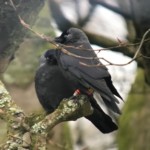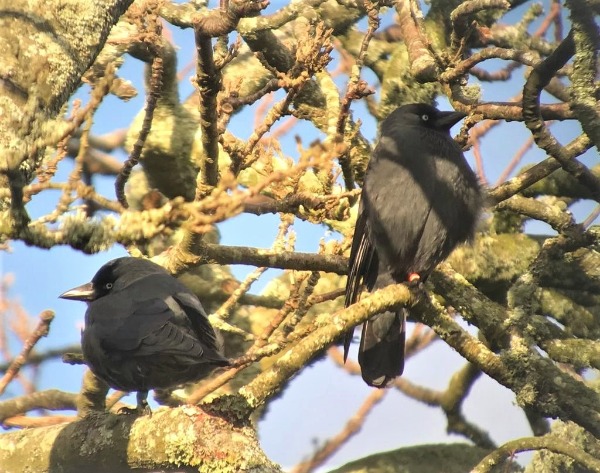Report from a BOU-funded project

Western Jackdaws (Corvus monedula), one of the most gregarious members of the crow family, are rarely observed alone. While they can be seen in flocks consisting of hundreds of individuals, they are most commonly spotted in pairs. Perhaps this is what inspired an English legend surrounding Western Jackdaws: in certain localities, they were once thought to be omens of a successful marriage (Porter and Barrett, 1969). In the present day, Western Jackdaws may not be viewed as harbingers of marital bliss but are well-known as a monogamous species forming long-term pair-bonds.
In birds, many species are socially but not genetically monogamous. This means that while pair-bonds are formed in most species, pairs tend not to exclusively mate with each other, and extra-pair offspring are often produced. Indeed, extra-pair offspring have been observed in over 90% of socially monogamous bird species (Griffith et al. 2002). In contrast, “strict monogamy”, where a species is socially, sexually and genetically monogamous, is highly unusual (Griffith et al., 2002).

Figure 1 A Western Jackdaw pair, ringed by the Cornish Jackdaw Project © Guill McIvor.
Two decades ago, two studies demonstrated that both a German and a UK population of Western Jackdaws were strictly (or almost strictly) monogamous (Liebers and Peter 1998; Henderson et al. 2000). The Western Jackdaw thus became well-known as a bird with “gold standard” monogamy: they stayed with their partner throughout life and mated only with them. This had implications not only for our understanding of strict monogamy in birds, but also for our understanding of social, sexual and cognitive evolution within Western Jackdaw populations.
However there were hints that something more complicated might be going on. While there was no (or extremely limited) evidence of extra-pair offspring in Western Jackdaws, there were inklings of non-monogamous behaviours reported in the literature. For instance, several researchers reported “follower” relationships, where a breeding pair were joined by a third individual whose relationship to the pair was unknown (Röell 1978; Liebers and Peter 1998). Moreover, individuals were observed sneaking into the nest-boxes of other pairs while the female was home alone, but what they got up-to inside remained unknown (Liebers and Peter 1998; Henderson et al. 2000).
The Cornish Jackdaw Project (CJP), headed by Dr Alex Thornton at the University of Exeter, set up a “surveillance state” on three Western Jackdaw populations in Cornwall, UK. This involved colour-ringing individuals so that they were identifiable, putting CCTV cameras inside their nest-boxes to monitor behaviour, and taking DNA samples (under licence) of pairs and their offspring. Using these data, we were able to interrogate the mating behaviour by analysing nest-box video data and building a genetic pedigree using DNA samples. To build a genetic pedigree, we used a new methodology called double digest restriction-site associated DNA sequencing (ddRADseq), which was funded in-part by the BOU. This sequencing allowed us to identify mutations in each individual’s DNA. By identifying many hundreds of these mutations per individual, the likelihood that an individual was in fact the offspring of its social parents could be calculated.
We found that most pairs were socially and genetically monogamous. However, this was not always the case. For instance, a male known to the CJP as “The Wasp”, because of his black and yellow colour rings, maintained a socially monogamous relationship with his partner while also mating with two other females. Both extra-pair females laid eggs (fertilised by The Wasp) in his nest-box. One of the extra-pair females was well-known to the CJP. Dubbed “Third Wheel”, she was observed following The Wasp around for multiple years, but relations between her and his actual partner appeared frosty. We even recorded a fight between them on video (Video 1), where The Wasp’s partner tried (and failed) to stop Third Wheel from entering her nest-box. Once inside, Third Wheel laid an egg, and we now know that her eggs were fertilised by The Wasp himself. Our analysis therefore revealed that at least in some cases, Western Jackdaw follower relationships are sexual as well as social in nature.
Video 1 Internal nest-box footage filmed by the Cornish Jackdaw Project. The resident female defends her nest-box against “Third Wheel”, who then enters. Shortly after this initial fight, Third Wheel lays an egg while the resident female is still inside the nest-box. Third Wheel then leaves. Genetic investigation revealed that Third Wheel’s egg was fertilised by the resident female’s partner.
In addition to non-monogamous follower relationships, we found evidence of forced extra-pair mating (Video 2). Specifically, we observed paired males waiting until neighbouring females were alone at the nest-box before entering and forcing copulation with them. The females would resist such extra-pair copulations and because of Western Jackdaw anatomy, this meant that they never or very rarely resulted in fertilisation. Indeed, a mere 0 – 4% of offspring were the result of forced extra-pair copulation. While we were unable to calculate the rate at which forced extra-pair copulations occurred, a study conducted in parallel to ours found that, in a German population, 82% of observed female birds were subjected to forced extra-pair copulations (Gill et al. 2020). Again, Gill et al. (2020) found that fertilisation through forced extra-pair copulation either did not occur or was extremely rare. Concurrently to both ours and the research of Gill et al. (2020), Turjeman et al. (2021) published a parentage study on an Israeli population of Western Jackdaws. Again, this study found that while most pairs were socially and genetically monogamous, some were not. The authors also saw extra-pair males sneaking into others’ nest-boxes while females were alone (Chen, R., personal communication), indicating that forced extra-pair copulations could be occurring in this population, too.
Video 2 Internal nest-box footage filmed by the Cornish Jackdaw Project. An example of forced extra-pair copulation, where the female (the bird in the box from the beginning of the video) resists copulation with a non-partner male (who enters the box shortly after the video begins).
In terms of mating systems, Western Jackdaws are now among the most intricately studied bird species both behaviourally and genetically. The main conclusion from this wealth of data is that Western Jackdaw sex lives are not as straight-forward as once presumed. While they do spend their life with a partner, another individual might just hop in and become a “third wheel” for a while producing offspring with a member of the pair. Moreover, while males may be highly attentive to and affiliative with their social partner, they may also force copulations with other females despite no or very few offspring resulting from such behaviour. The sex lives of jackdaws are thus a complicated affair, which cannot be characterised with the blanket term of “strict monogamy”. When considered together, these findings raise intriguing further questions, such as why follower relationships arise, why males pursue forced extra-pair copulations, and what the social and cognitive implications of these behaviours are?
If what we know now had been known at the time that jackdaw folklore originated, perhaps this species would not be considered an omen of marital bliss after-all.
Funding
Beki Hooper (PhD Candidate) was awarded an ornithological research grant for £2,000 in 2018 for a project entitled ‘The secret lives of Jackdaws: exploring sexual monogamy in a socially monogamous species’. This award contributed towards work that formed Beki’s PhD.
References
Gill, L.F., van Schaik, J., von Bayern, A.M.P. & Gahr, M.L. 2020. Genetic monogamy despite frequent extrapair copulations in “strictly monogamous” wild jackdaws. Behavioral Ecology 31: 247-260. VIEW
Griffith, S.C., Owens, I.P.F & Thuman, K.A. 2002. Extra pair paternity in birds: a review of interspecific variation and adaptive function. Molecular Ecology 11: 2195-2212. VIEW
Henderson, I.G., Hart, P.J.B. & Burke, T. 2000. Strict monogamy in a semi-colonial passerine: the jackdaw (Corvus monedula). Journal of Avian Biology 31: 177-182. VIEW
Liebers, D. & Peter, H.-U. 1998. Intraspecific interactions in jackdaws Corvus monedula: a field study combined with parentage analysis. Ardea 86: 221-235. VIEW
Porter, E. & Barrett, W.H. 1969. Cambridgeshire customs and folklore. Routledge
Röell, A. 1978. Social behaviour of the jackdaw, Corvus monedula, in relation to its niche. Behaviour 64: 1-124. VIEW
Turjeman, S., Chen, R. & Nathan, R. 2021. Absence of strict monogamy in the Eurasian jackdaw, Coloeus monedula. Israel Journal of Ecology and Evolution 49: 1-5. VIEW
Image credit
Top right: A jackdaw pair, ringed by the Cornish Jackdaw Project © Guill McIvor.
If you want to write about your research in #theBOUblog, then please see here.





